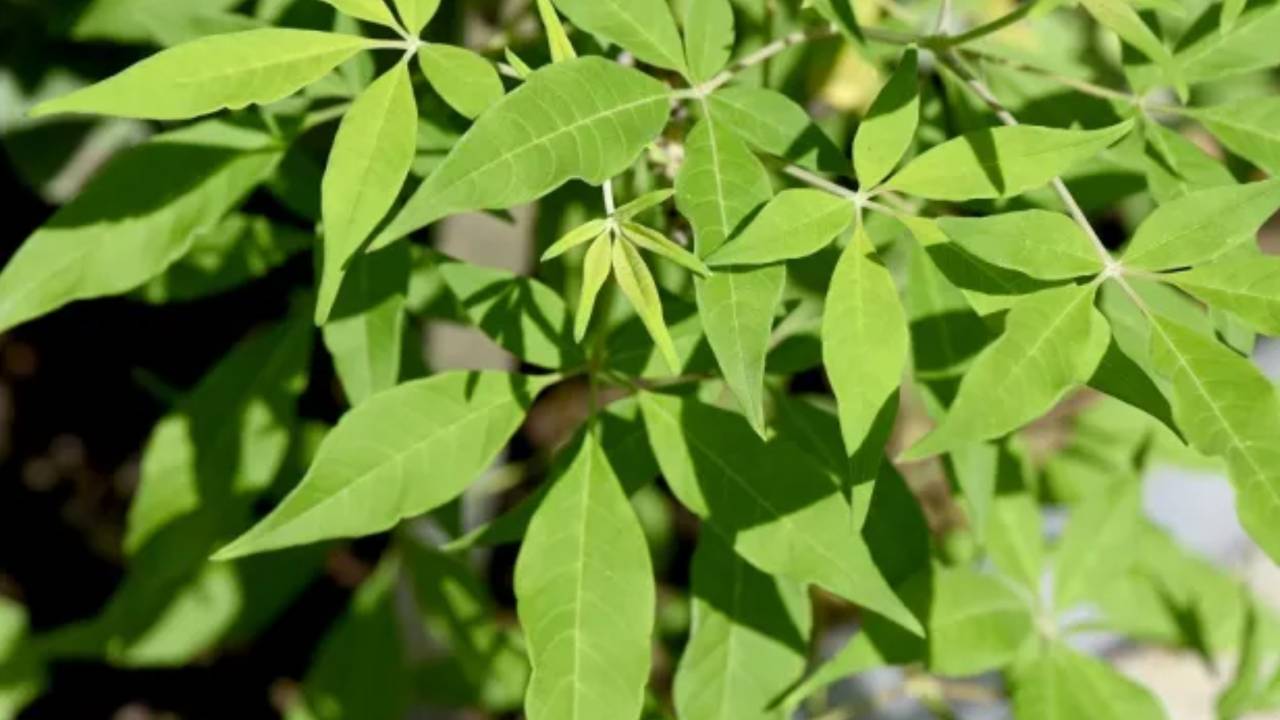Nirgundi: Benefits, Uses, Side Effects – A Comprehensive Guide
Nirgundi, often referred to as Vitex negundo in botanical terms, is a prominent herbal remedy deeply rooted in Ayurvedic medicine. This time-honored botanical treasure has been cherished for centuries due to its diverse therapeutic properties and holistic approach to healing. 
In this exploration, we delve into the rich tradition of Nirgundi as an Ayurvedic medicine, uncovering its profound impact on health and well-being.
What is Nirgundi in Ayurveda?
Nirgundi is an Ayurvedic medicine derived from the dried leaves of Vitex negundo, which belongs to the Verbenaceae family. This plant is a fragrant shrub or small tree that can grow up to 4.5 meters in height. It is widely distributed across India, including the outer Himalayas up to an altitude of 1500 meters.
Vitex negundo is commonly known as the “Five-leaved chaste tree.” It belongs to a diverse family of herbs, shrubs, and trees, comprising approximately 75 genera and nearly 2500 species. In Sanskrit, Vitex negundo goes by the names Nirgundi and Sindhuvara.
Nirgundi has a long history of clinical use in traditional systems of medicine, including Ayurveda, Unani, and Siddha. It has been employed for various purposes, such as managing pain, headaches, inflammation, leukoderma (skin disorder), spleen enlargement, rheumatoid arthritis, gonorrhea, bronchitis, and even for treating common ailments like fever, cold, and cough.
Additionally, the leaves of Vitex negundo have been noted for their pesticidal and antifungal properties. This versatile plant has earned its place as a valuable natural resource in traditional medicine systems and continues to be explored for its potential in modern healthcare practices.
The Mythological Tale of Nirgundi
In India, Nirgundi holds a sacred status and is deeply intertwined with mythology. According to ancient beliefs, Nirgundi is thought to have originated from the abdomen of Lord Ganesha, one of the most revered deities in Hinduism.
This mythological tale adds a layer of sanctity to the plant’s significance in Indian culture.In religious rituals and practices, Nirgundi plays a vital role. The leaves of the Nirgundi plant are offered as a symbol of devotion to Lord Shiva and Goddess Parvati, also known as Gouri.
This offering takes place during the Nithya Somavara Vrata, a significant religious observance dedicated to Lord Shiva.
The act of presenting Nirgundi leaves in rituals is a way of expressing reverence and seeking blessings from these divine entities. It underscores the plant’s spiritual importance and its deep-rooted connection to India’s religious heritage.
Ayurvedic properties
- Taste (Rasa): Nirgundi is characterized by a pungent (Katu) and bitter (Tikta) taste.
- Attributes (Guna): It possesses the qualities of being light (Laghu) and dry (Ruksha).
- Potency (Virya): Nirgundi has a hot (Ushna) potency.
- Metabolic Effect (Vipaka): In terms of metabolic effect, it has a pungent (Katu) post-digestive taste.
- Action on Doshas (Doshakarma): Nirgundi primarily pacifies Kapha and Vata doshas, making it beneficial in managing conditions associated with these doshas in Ayurveda.
The Ayurvedic actions or effects of Nirgundi
1. Kaphahara: Pacifies Kapha Dosha.
2. Kapha-Vatahar: Removes the Humor of Kapha-Vata.
3. Kasa-shvashar: Provides relief in cough and Asthma.
4. Krimighna: Destroys worms.
5. Shothhar: Reduces inflammation.
6. Vatahara: Pacifies Vata Dosha.
7. Vishaghna: Destroys poison.
8. Vranashodhana: Cleans wounds.
Vernacular Names and Classification
- Botanical Name: Vitex negundo
- Sanskrit Names: Nirgundi, Sindhuvara, Neelamanjari, Indrasurasa, Bhoothakeshi, Neelika
- Hindi Names: Samhalu, Saubhalu, Nirgandi
- English Name: Five-leaved chaste tree
- Bengali Names: Nirgundi, Nishinda
- Gujarati Name: Nagod
- Kannada Name: Bile-nekki
- Malayalam Name: Indrani
- Telugu Names: Nallavalli, Vavilli, Tellavavilli
- Tamil Names: Nirkunnchi, Nallanochi
- Marathi: Nirgundi
- Punjabi: Banmairandi
- Oriya: Nigundi
- Assamese: Nilanirgundi
- Nepali: Nirgundi
- Sinhala: Nika
- Burmese: Nat-ma-ywe
- Thai: Noi, Aenoi
- Laotian: Khon noi
- Cambodian: Voan saich krahom
- Vietnamese: Boi hong
- Filipino: Lagundi
- Indonesian: Balakulandu
- Malay: Kacang-kacangan
Nirgundi plant chemical constituents
Nirgundi contains at least 0.25 percent of negundoside and 1.0 percent of agnuside when assayed. The following table contains the chemical components present in the Nirgundi plant:
1. Leaves:
- Vitamin-C
- Artemetin
- Terpinen-4-ol
- α-Terpineol
- Sabenine
- Globulol
- Spathulenol
- β-Farnesene
- Farnesol
- Carotene
- Casticin
- 5-Hydroxy-6,7,8, 4′-Tetramethoxy (Gardenin B)
- Linalool
- Stearic acid
- 5-Hydroxy-3,6,7,3′, 4′-Pentamethoxy Flavone
- 5-Hydroxy-3,7,3′, 4′-Tetramethoxy Flavones
- Betulinic acid
- Ursolic acid.
2. Seeds:
- β-Sitosterol
- p-Hydroxybenzoic acid
- 5-Oxyisophthalic acid
- Artemetin
- Vitedoin A
- Vitedoamine A
- Vitedoin B
- 2β,3α-Diacetoxyoleana-5,12-dien-28-oic acid
- 3β-Acetoxyolean-12-en-27-oic acid
- n-Tritriacontane
- n-Hentriacontane
- n-Pentatriacontane
- β-Sitosterol.
3. Stem and Bark:
- 3,6,7,3′,4′-Pentamethoxy-5-O-glucopyranosylrhamnoside
- Vitexin cafeate
- 4′-O-methyl myricetin-3-O-[4′-O-β-D-galactosyl]-β-D-galactopyranoside
- β-Amyrin
- Epifriedelinol
- Oleanolic acid
- p-Hydroxybenzoic acid
- β-Sitosterol.
4. Roots:
- Vitexin and isovitexin
- Vitexoside
- Negundin A
- Negundin B
- 6-Hydroxy-4-(4-hydroxy-3-methoxy)-3-hydroxymethyl-7-methoxy-3,4-dihydro-2-naphthaledehyde
- 2β,3α-Diacetoxyoleana-5,12-dien-28-oic acid.
Nirgundi’s varied Medicinal Properties
Nirgundi is celebrated for its diverse range of medicinal properties, making it a valuable resource in the world of herbal remedies. Let’s take a closer look at some of its most prominent attributes:
1. Antibacterial Power: One of nirgundi’s standout features is its antibacterial prowess. This medicinal plant contains active compounds that inhibit the growth of harmful bacteria. This property makes it an effective natural remedy for various bacterial infections.
2. Laxative Aid: Nirgundi has been traditionally used as a natural laxative. Its consumption can help promote regular bowel movements, providing relief from constipation and related discomfort.
3. Antioxidant Richness: Antioxidants are crucial for combating oxidative stress and preventing cellular damage. Nirgundi is loaded with antioxidants that protect the body from the harmful effects of free radicals, helping to maintain overall health.
4. Anticonvulsant Effects: Research suggests that nirgundi possesses anticonvulsant properties, making it a potential option for managing conditions characterized by seizures and convulsions. Further studies are needed to explore its full potential in this regard.
5. Hypoglycemic Benefits: For individuals dealing with diabetes or those looking to manage their blood sugar levels, nirgundi holds promise. It has hypoglycemic properties that may help regulate glucose levels in the body.
6. Anti-Inflammatory Action: Inflammation is at the root of many chronic diseases. Nirgundi’s anti-inflammatory properties make it an excellent natural remedy for conditions involving inflammation, such as arthritis and inflammatory bowel diseases.
Nirgundi’s Roots in Traditional Medicine
Nirgundi’s therapeutic applications are deeply rooted in traditional medicine systems across the world, particularly in Ayurveda. The various parts of this plant are used in herbal formulations to address a wide array of health concerns.
Nirgundi Roots in ‘Dashamularishta’ formulation
The roots of nirgundi play a significant role in Ayurvedic medicine in the herbal formulation known as ‘Dashamularishta’ and one of the key ingredients is nirgundi. This formulation is renowned for its effectiveness in treating a range of ailments, including:
1. Colitis: Inflammation of the colon.
2. Dysentery: An infectious disease characterized by severe diarrhea with the presence of blood and mucus in the stool.
3. Diarrhea: Frequent, loose bowel movements.
4. Flatulence: Excessive gas in the digestive tract.
5. Fever: Elevated body temperature, often indicative of an underlying infection.
6. Vomiting: The forceful expulsion of stomach contents through the mouth.
7. Colic: Severe, often fluctuating abdominal pain, particularly in infants.
The inclusion of nirgundi roots in Dashamularishta underscores its significance as a potent herbal remedy.
The Bioactive Components of Nirgundi
Nirgundi owes its therapeutic potential to a rich array of bioactive compounds present in its various parts. Some of the notable constituents include:
1. Nisindine: An alkaloid found in nirgundi, which contributes to its medicinal properties.
2. Flavonoids: Compounds like flavones and luteolin-7-glycoside, which possess antioxidant and anti-inflammatory properties.
3. Essential Oil: Nirgundi contains essential oils that may have unique therapeutic applications.
4. Vitamin C: An essential nutrient known for its role in immune support and overall health.
5. Carotene: A precursor to vitamin A, crucial for maintaining healthy skin and vision.
These constituents collectively contribute to nirgundi’s diverse range of biological actions.
Benefits of Nirgundi: A Remedy for Various Health Concerns
Nirgundi, scientifically known as Vitex negundo, is a medicinal plant that has been extensively studied for its therapeutic properties.
From battling infections to aiding in pain relief, supporting liver health, and even managing chronic conditions like arthritis and diabetes, nirgundi offers a wide range of health benefits.
In this article, we’ll explore the manifold advantages of incorporating nirgundi into your health and wellness regimen.
1. Nirgundi’s Anti-Infection Properties
Antibacterial Power: Nirgundi essential oil has demonstrated remarkable antibacterial activity against several strains of bacteria, including B. subtilis, S. aureus, E. coli, and P. aeruginosa. This property makes it a valuable natural remedy for combating bacterial infections.
Antifungal Activity: Nirgundi leaf extracts contain a newly discovered flavone glycoside with potent antifungal properties. It has been shown to effectively combat fungi such as Cryptococcus neoformans and Trichophyton mentagrophytes, offering potential relief for fungal infections.
2. Nirgundi’s Role in Pain Management
Anti-Inflammatory and Analgesic Effects: Fresh nirgundi leaves possess anti-inflammatory properties, attributed to their ability to inhibit the synthesis of prostaglandins, molecules involved in pain and inflammation. Studies on animals have compared the pain-relieving effects of nirgundi extracts to well-known painkillers like aspirin and meperidine, suggesting its potential as a natural analgesic.
Adjuvant Therapy: Research has indicated that nirgundi leaves exhibit strong analgesic activity. This implies that they can be used in conjunction with standard analgesic medications, potentially enhancing their pain-relieving effects.
3. Nirgundi’s Benefits for Liver Health
Liver Enzyme Regulation: Extracts from V. negundo seeds have been found to reduce serum levels of liver enzymes, such as aspartate transaminase and alanine transaminase. This indicates a positive impact on liver function and health.
Protection Against Liver Toxicity: Alcoholic seed extracts of nirgundi have shown a protective effect against liver toxicity induced by substances like Carbon-tetrachloride (CCL4), further underlining its potential as a liver health supplement.
4. Nirgundi’s Role in Arthritis Management
Rheumatoid Arthritis Relief: Heated nirgundi leaves have traditionally been used to alleviate pain associated with rheumatoid arthritis and sprains. This natural remedy offers an alternative approach to managing arthritis-related discomfort.
5. Nirgundi’s Benefits for Respiratory Health
Managing Bronchitis and Asthma: Decoctions made from nirgundi roots have been employed in traditional medicine for managing respiratory conditions such as bronchitis and asthma. This suggests a potential role in supporting lung health.
6. Nirgundi’s Contribution to Diabetes Management
Anti-Hyperglycemic Activity: Leaf extracts of Vitex Negundo have demonstrated anti-hyperglycemic activity in animal studies. While further research is needed, this finding hints at the possibility of nirgundi playing a role in blood sugar regulation.
7. Nirgundi’s Wound-Cleaning Properties
Wound Cleansing: Nirgundi leaves’ extract can be employed to clean infected ulcers, aiding in the wound healing process.
8. Nirgundi’s Potential for Skin Health
Combatting Skin Infections: Nirgundi leaf juice may be beneficial in managing bacterial and parasitic skin infections, providing a natural solution for various skin-related concerns.
Managing Skin Diseases: Nirgundi seeds have been traditionally used to address skin diseases and conditions like leprosy, showcasing their versatility in skin health management.
9. Nirgundi as an Antioxidant
Potent Antioxidant Activity: Certain water-soluble constituents found in Vitex negundo possess potent antioxidant properties. While human studies are needed to confirm its efficacy in humans, these findings hint at nirgundi’s potential as a natural antioxidant.
How to Utilize the Healing Powers of Nirgundi Plant
Nirgundi, scientifically known as Vitex negundo, offers a wealth of therapeutic benefits, and various parts of this plant can be harnessed for medicinal purposes. Here’s a guide on how to use different components of the Nirgundi plant for various health concerns:
Nirgundi Leaves
1. Inhalation: Nirgundi leaves can be boiled with water, and the vapors can be inhaled. This method is often employed to provide relief from respiratory issues and congestion.
2. Headache Relief: Ground Nirgundi leaves can be made into a paste and applied on the forehead to alleviate headaches.
Nirgundi Flowers
1. Fever Management: Flower extracts of Nirgundi may be utilized in the management of fever. These extracts might help reduce body temperature and alleviate fever-related symptoms.
2. Diarrhea and Liver Complaints: Nirgundi flower extracts could be beneficial in addressing issues related to diarrhea and liver complaints. Their potential effectiveness in these areas makes them a valuable natural remedy.
Nirgundi Seeds
1. Swelling Management: Nirgundi seeds can be used in conjunction with sugarcane or vinegar to manage swellings effectively. This combination may help reduce inflammation and promote healing.
2. Spermatorrhea and Aphrodisiac: Powdered Nirgundi seeds can be employed in the management of conditions like spermatorrhea (involuntary ejaculation). Additionally, when used with dry ginger and milk, these seeds can serve as an aphrodisiac, potentially enhancing sexual health.
3. Fracture Healing: Nirgundi seeds can be made into a paste and combined with salt and pepper. This paste can be applied topically to fractures, possibly aiding in the healing process.
Nirgundi Roots
1. Dysentery Management: Root powder and tincture derived from Nirgundi roots can be used to manage dysentery, a condition characterized by diarrhea containing blood and mucus.
2. Anthelmintic Property: The powdered root of Nirgundi has anthelmintic properties, meaning it may help expel parasitic worms from the body.
3. Kidney Health: Root extract can be dissolved in tender coconut water for a week. This preparation may be used to address kidney-related problems, although it’s advisable to consult a healthcare professional for specific kidney concerns.
Nirgundi Fruit
1. Menstrual Disorders: The dried fruit powder of Nirgundi can be taken orally with roasted common salt and warm water to manage menstrual disorders. It may help regulate menstrual cycles and alleviate associated discomfort.
2. Urinary Disorders: Similar to menstrual disorders, the dried fruit powder may also be beneficial in addressing urinary disorders, promoting better urinary health.
3. Indigestion: When consumed with warm water, the dried fruit powder of Nirgundi may assist in managing indigestion, offering relief from digestive discomfort.
Note: Nirgundi’s versatility in addressing various health concerns makes it a valuable asset in traditional and complementary medicine.
However, it’s crucial to consult with a qualified healthcare practitioner or herbalist before using Nirgundi or any herbal remedy.
Especially if you have underlying health conditions or are taking medications. Proper dosages and usage instructions should be followed to ensure safe and effective use.
Nirgundi Plant Home Remedies
1. Nirgundi Leaf Poultice for Pain Relief:
- Take a handful of Nirgundi leaves and grind them into a paste.
- Apply the paste to the affected area, whether it’s a joint pain, muscle ache, or a sprain.
- Secure it with a clean cloth and leave it on for a few hours.
- Nirgundi’s analgesic properties can help alleviate pain and inflammation.
2. Nirgundi Infusion for Cough and Cold:
- Boil Nirgundi leaves in water to make an herbal infusion.
- Add a teaspoon of honey and a pinch of black pepper for flavor.
- Drink this concoction to ease symptoms of cough, cold, and congestion.
- Nirgundi’s anti-inflammatory properties can help soothe irritated respiratory passages.
3. Nirgundi Oil for Skin Conditions:
- Prepare Nirgundi oil by infusing Nirgundi leaves in a carrier oil like coconut or sesame oil.
- Apply this oil topically to skin conditions such as eczema, psoriasis, or acne.
- The antimicrobial and anti-inflammatory properties of Nirgundi can promote skin healing.
4. Nirgundi Herbal Tea for Digestive Issues:
- Make a herbal tea using dried Nirgundi leaves.
- Sip on this tea to relieve digestive problems like indigestion, bloating, and gas.
- Nirgundi’s carminative properties can help soothe the digestive tract.
5. Nirgundi Paste for Headaches:
- Create a paste from fresh Nirgundi leaves by grinding them.
- Apply the paste on your temples and forehead to alleviate headaches.
- The analgesic and cooling properties of Nirgundi can provide relief from head discomfort.
6. Nirgundi Leaf Mouthwash for Oral Health:
- Boil Nirgundi leaves and let the water cool.
- Use it as a mouthwash to maintain oral hygiene and combat issues like bad breath and gum inflammation.
- Nirgundi’s antibacterial properties can help keep your mouth fresh and healthy.
Tips: While Nirgundi can be a valuable natural remedy, it’s important to use it safely and in moderation.
Precautions and Side Effects of Using Nirgundi
While Nirgundi, or Vitex negundo, offers numerous health benefits, it’s important to use this medicinal plant with caution and be aware of potential side effects. Here are some precautions and possible side effects to consider:
Precautions:
1. Allergic Reactions: Individuals with known allergies to plants in the Lamiaceae family, which Nirgundi belongs to, should exercise caution. Allergic reactions can include skin rashes, itching, or respiratory symptoms. If you suspect an allergy, discontinue use and seek medical attention.
2. Pregnancy and Breastfeeding: Pregnant and breastfeeding women should consult a healthcare professional before using Nirgundi, as its safety during these periods is not well-established. Some compounds in Nirgundi may affect hormonal balance.
3. Children: The use of Nirgundi in children should be supervised by a qualified healthcare provider. Dosages and applications should be carefully determined based on the child’s age and specific health needs.
4. Underlying Health Conditions: If you have underlying health conditions, such as liver or kidney disorders, it’s advisable to consult a healthcare practitioner before using Nirgundi, as it may interact with certain medications or exacerbate pre-existing conditions.
5. Dosage and Duration: Always follow recommended dosages and usage guidelines provided by a healthcare professional or on product labels. Overuse or prolonged use of Nirgundi can lead to adverse effects.
Possible Side Effects:
1. Gastrointestinal Distress: Some individuals may experience mild gastrointestinal discomfort, such as stomach upset or diarrhea, when using Nirgundi, especially if taken in large amounts.
2. Skin Irritation: Topical application of Nirgundi preparations, such as pastes or poultices, can occasionally lead to skin irritation or allergic reactions in sensitive individuals.
3. Hormonal Effects: Certain compounds in Nirgundi may have hormonal effects. Women with hormone-sensitive conditions, such as breast cancer or endometriosis, should use Nirgundi cautiously and under medical supervision.
4. Drug Interactions: Nirgundi may interact with certain medications, including anticoagulants (blood thinners), antiplatelet drugs, and drugs that affect blood sugar levels. If you’re taking any medications, consult your healthcare provider before using Nirgundi to avoid potential interactions.
5. Overuse: Excessive use of Nirgundi, especially in the form of essential oils or extracts, can lead to skin irritation, digestive issues, or other adverse effects. Stick to recommended dosages and applications.
6. Allergic Reactions: As mentioned earlier, some individuals may be allergic to Nirgundi or related plants. If you experience symptoms like skin rashes, itching, swelling, or difficulty breathing, seek immediate medical attention.
Recommended Nirgundi Dosage
- Nirgundi Juice: Consume 10-20 ml per day, or adjust as needed based on individual requirements.
- Nirgundi Powder: Take 1.5-3 grams daily, or adjust the dosage according to your specific needs.
How to Use Nirgundi
1. Nirgundi Juice:
- Take 10-20 ml of Nirgundi leaf juice or follow your physician’s guidance.
- Consume it twice daily after meals.
- Continue this regimen daily to alleviate cough symptoms.
2. Nirgundi Powder
- Take 3-6 grams of Nirgundi powder or as advised by your physician.
- Mix it with lukewarm water.
- Follow this routine regularly to find relief from rheumatic pain and swelling.
3. Nirgundi Capsules
- Take 1 capsule or follow your physician’s instructions, twice a day.
- Consume them consistently after meals.
- Maintain this daily routine to ease generalized body pain.
Frequently Asked Questions (FAQs) on Nirgundi
1. Is Nirgundi safe for everyone to use?
Yes, Nirgundi is generally safe for most people. However, it’s advisable to consult with a healthcare professional, especially if you are pregnant, nursing, or taking medications.
2. How can I use Nirgundi for pain relief?
For topical pain relief, you can make an oil infusion using Nirgundi leaves and apply it to the affected area. For internal use, consult with an Ayurvedic practitioner for guidance.
3. Can I grow Nirgundi at home?
Absolutely! Nirgundi is well-suited for home gardening. It requires well-drained soil and regular sunlight.
4. Are there any side effects of using Nirgundi?
While Nirgundi is generally safe, excessive use may lead to digestive discomfort or skin irritation. Always use it in moderation.
5. Where can I purchase Nirgundi products?
Nirgundi products are available at health food stores, herbal shops, and online retailers. Ensure you buy from reputable sources for quality assurance.
Nirgundi is a revered Ayurvedic herbal remedy known for its versatile healing properties and traditional use in managing various health conditions.
References:
- Antidiabetic Potential of Aqueous and Ethanol Leaf Extracts of Vitex negundo(1)
- A REVIEW OF ETHNOMEDICINAL PLANT-Vitex negundo Linn(2)
- Hepatoprotective Activity on Vitex negundo Linn. (Verbenaceae) by using Wistar Albino Rats in Ibuprofen Induced Model(3)
- Medicinal property of Nirgundi(4)
- Phytochemical investigation and Antipyretic activity of leaf extract of Vitex negundo Linn(5)
- ANTIOXIDANT AND ANTIINFLAMMATORY EFFECTS OF VITEX NEGUNDO ON FREUND’S COMPLETE ADJUVANT INDUCED ARTHRITIS(6)
- Nirgundi (Vitex negundo) – Nature’s Gift to Mankind(7)
- Therapeutic Review of Nirgundi in Ayurvedic Classics(8)


























